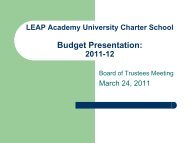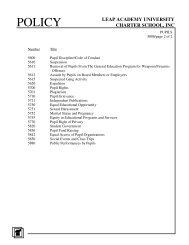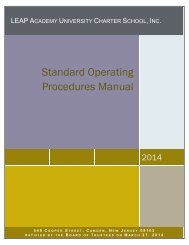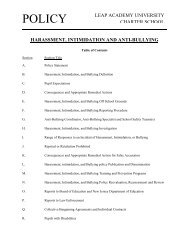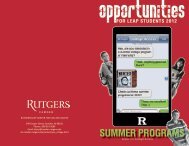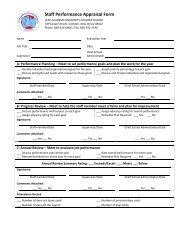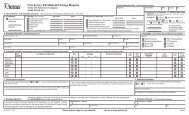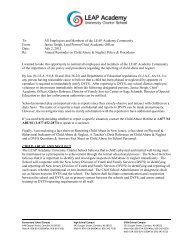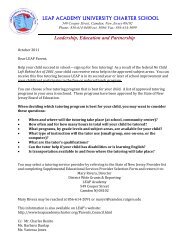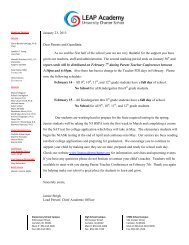Staff Performance Appraisal Form - LEAP Academy University ...
Staff Performance Appraisal Form - LEAP Academy University ...
Staff Performance Appraisal Form - LEAP Academy University ...
Create successful ePaper yourself
Turn your PDF publications into a flip-book with our unique Google optimized e-Paper software.
<strong>Staff</strong> <strong>Performance</strong> <strong>Appraisal</strong> <strong>Form</strong><strong>LEAP</strong> ACADEMY UNIVERSITY CHARTER SCHOOLEmployee Name: Evaluation Period: From ToSupervisor:Date:Job Title:Type of Report: □ Probationary □ Interim □ AnnualCOMMUNICATION OF PERFORMANCE STANDARDSIndicate when you conveyed job standards to the employee and when progress review(s) wasconducted:1. <strong>Performance</strong> standards (objectives, duties, expectations, etc.) for this rating period wereconveyed to employee on: _____________________________________________2. Progress Review(s) was conducted on ______________________________________________________(at least one during rating cycle)KEY JOB RESPONSIBILITIESList the key job responsibilities providing a brief description of each.Key Duty #1:Key Duty #2:Key Duty #3:Key Duty #4:Key Duty # 5:
JOB FACTORS1. JOB KNOWLEDGE/SKILLS Measures employee’s demonstrated job relevant knowledge and essential skills, such as workpractices, policies, procedures, resources, laws, customer service, and technical information, as well as the relationship ofwork to the organization’s mission. Also measured are the employee’s self-improvement efforts to enhance skills andknowledge and to stay current with changes impacting the job.OUTSTANDING□ Possesses superior jobskills and knowledge:effectively appliesthem to workassignments. Willingly mentorsstaff; sharesknowledge. Seeks/appliesinnovative andrelevant techniques.Comments:COMMENDABLE□ Work reflects thoroughand currentknowledge/skill of joband impact on agencyactivities/relatedresources. Uses opportunities toexpandknowledge/skills,sharing informationwith staff.SATISFACTORY□ Work reflectsadequateknowledge/skills forjob. Has some knowledgeof related work. Stays current withmajor changesimpacting onknowledge or skills.Accepts change.NEEDS IMPROVEMENT□ Often demonstrates a lack ofbasic or sufficient jobknowledge/skills to performroutine functions of the job. Occasionally is resistant tochanging knowledge and/orskill requirements orprocesses, includingopportunities forknowledge/skillenhancement.UNSATISFACTORY□ Consistentlydemonstrates a lackof basic jobknowledge and/orskills to perform job. Rarely takesadvantage ofavailable skillenhancement ortrainingopportunities. Often is resistant tochangingrequirements.2. WORK RESULTS Measures employee’s results in meeting established objectives/expectations/standards of quality,quantity, customer service, and timeliness both individually and in a team.OUTSTANDING□ Work consistentlyexceeds expectationsof quality, quantity,customer service, andtimeliness.COMMENDABLE□ Work frequentlyexceeds expectedquality, quantity,customer service, andtimeliness standards.SATISFACTORY□ Work usually meetsexpectations ofquality, quantity,customer service, andtimeliness.NEEDS IMPROVEMENT□ Often has difficulty meetingexpected quality, quantity,customer service, and/ortimeliness standards.UNSATISFACTORY□ Consistently fails tomeet expectedquality, quantity,customer service,and/or timelinessstandards.Comments:
3. COMMUNICATIONS Measures employee’s performance in exchanging information with others in an effective, timely,clear, concise, logical, and organized manners. Communications include listening, speaking, writing, presenting, and sharing ofinformation. Consideration is given to client/data complexity/sensitivity.OUTSTANDING□ Consistentlycommunicates in clear,effective, timely,concise, and organizedmanner. Is articulate andpersuasive inpresenting, solicitingcomplex or sensitivedata.COMMENDABLE□ Frequentlycommunicates in aneffective, timely, clear,concise, and organizedmanner. Proficiently organizesand presents difficultfacts and ideas orallyand in writing. Seeks/providesfeedback.SATISFACTORY□ Usuallycommunicateseffectively andexchanges relevantinformation in atimely manner. Speaks and writesclearly. Keeps othersinformed. Listens withunderstanding.NEEDS IMPROVEMENT□ Often fails to communicateeffectively or in a timelymanner. Lacks clarity of expressionorally or in writing. Is inconsistent in keepingothers informed. At times, fails to listeneffectively.UNSATISFACTORY□ Consistently fails tocommunicateeffectively or timely. Often does not keepothers informed. Is an ineffectivelistener and/orfrequently interrupts.Comments:4. INITIATIVE/PROBLEM SOLVING Measures the extent to which the employee is self-directed, resourceful, and creative inperforming job duties individually or in a team. Also measures employee’s performance in identifying and resolving problems;following through on assignments; and initiating or modifying ideas, methods, or procedures to provide improved customerservice, redesign business processes, and accomplish duties.OUTSTANDING□ Consistently resolvesunit/team problemsand promotesimprovements. Maximizes resources,innovation/technologytostreamline/improve. Analyzes fulldimension of complexproblems. Requires minimalsupervision.Comments:COMMENDABLE□ Prevents/resolvesunit/team problems. Suggests innovations toimprove operations orstreamline procedures. Defines and analyzescomplex problems. Develops/implementssolutions withmoderate supervision.SATISFACTORY□ Addresses existingand significantpotential problems. Suggests or assists indeveloping solutionsindividually or in ateam. Carries throughsolutionimplementation withroutine supervisionor follow-up.NEEDS IMPROVEMENT□ Resolves routine problems. Exhibits little initiative inidentifying problems,solutions, or improvementsand/or working proactivelyas part of a team to addressissues of concern. Requires more than routinesupervision.UNSATISFACTORY□ Consistently fails torecognize or seekhelp in resolving orseek help in resolvingroutine problems. Demonstratesinability to workindividually or in ateam. Rarely suggestsimprovements. Requires frequentreminders andsupervision.
5. INTERPERSONAL RELATIONS Measures employee’s development and maintenance of positive and constructiveinternal/external relationships. Consideration should be given to the employee’s demonstrated willingness to function asa team player, give and receive constructive criticism, accept supervision, resolve conflicts, recognize needs andsensitivities of others, and treat others in a fair and equitable manner.OUTSTANDING□ Consistently promotesand maintains aharmonious/productivework environment. Is respected and trustedand often viewed as arole model.COMMENDABLE□ Frequently fostersteamwork,cooperation, andpositive workrelationships. Handles conflictconstructively.SATISFACTORY□ Usually interacts in acooperative manner. Avoids disruptivebehavior. Deals withconflict, frustrationappropriately. Treats othersequitably.NEEDS IMPROVEMENT□ Often has difficulty gettingalong with others. Allowspersonal bias to affect jobrelationships. Requires remindersregarding needs andsensitivities of others.UNSATISFACTORY□ Interpersonalrelationships arecounter-productive towork unit or teamfunctions.Comments:6. WORK HABITS Measures employee’s performance relative to efficient methods of operation, customer service, properconduct, speech, ethical behavior, and Commonwealth/agency/work unit policies and procedures, such as attendance,punctuality, safety, security, proper care and maintenance of assigned equipment, and economical use of supplies.OUTSTANDING□ Work reflectsmaximum innovativeuse of time andresources toconsistently surpassexpectations andimprove operations. Services as role modelwith regard to workpolicies and safetystandards.Comments:COMMENDABLE□ Frequentlyplans/organizes workto timely and effectivelyaccomplish job dutieswith appropriate use ofresources. Suggests/implementsimprovements andexceeds organizationalwork/safety rules andstandards.SATISFACTORY□ Work is planned tomeet routine volumeand timeliness andusually fulfillsoperational andcustomer serviceneeds. Adheres toorganizational workpolicies/safety rulesand procedures withfew exceptions.NEEDSIMPROVEMENT□ Frequently lacksorganization and planningof work and does notadequately use availableresources. Often does not meetstandards in complyingwith work policies/safetyrules and/or care ofequipment.UNSATISFACTORY□ Consistently fails tomeet expectedstandards due to lackof effectiveorganization, use ofequipment/resources,or inattention tocustomer serviceneeds. Resists establishedwork policies/safetyrules and procedures.
Overall Comments:EMPLOYEE STRENGTHS: (Identify strong attributes, abilities, or proficiency in an area, to maximize the employee’scontribution to the organization in utilizing these abilities and skills and to identify potential mentor relationships.)Comments:OPPORTUNITIES FOR DEVELOPMENT: (Identify knowledge, skills, and abilities that may need improvement. Addressdevelopment activities to assist the employee in addressing either areas of concern or opportunities for professional growth.)Comments:Comments:SUPERVISOR’S COMMENTSSupervisor’s Signature:Date:EMPLOYEE’S COMMENTS□ I AGREE WITH THIS RATING□ I DISAGREE WITH THIS RATING□ I WOULD LIKE TO DISCUSS THIS RATING□ DISCUSSION WITH MY SUPERVISOR OCCURRED ______________________(DATE)□ I ACKNOWLEDGE THAT I HAVE READ THIS REPORT AND I HAVE BEEN GIVEN AN OPPORTUNITY TO DISCUSSIT WITH THE EVALUATOR. MY SIGNATURE DOES NOT NECESSARILY MEAN THAT I AGREE WITH THE REPORT.Comments:Employee’s Signature:Date:First Level Supervisor:Date:Second Level Supervisor:Date:Chief Academic Officer:Date:




